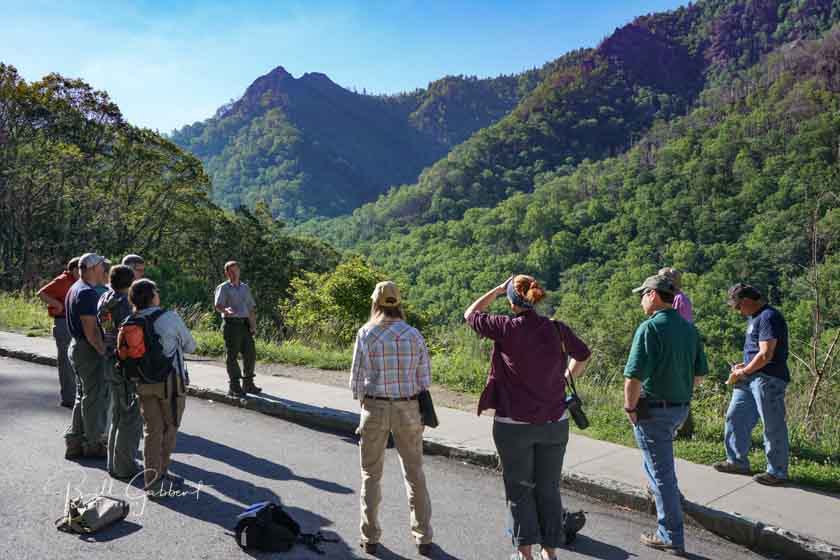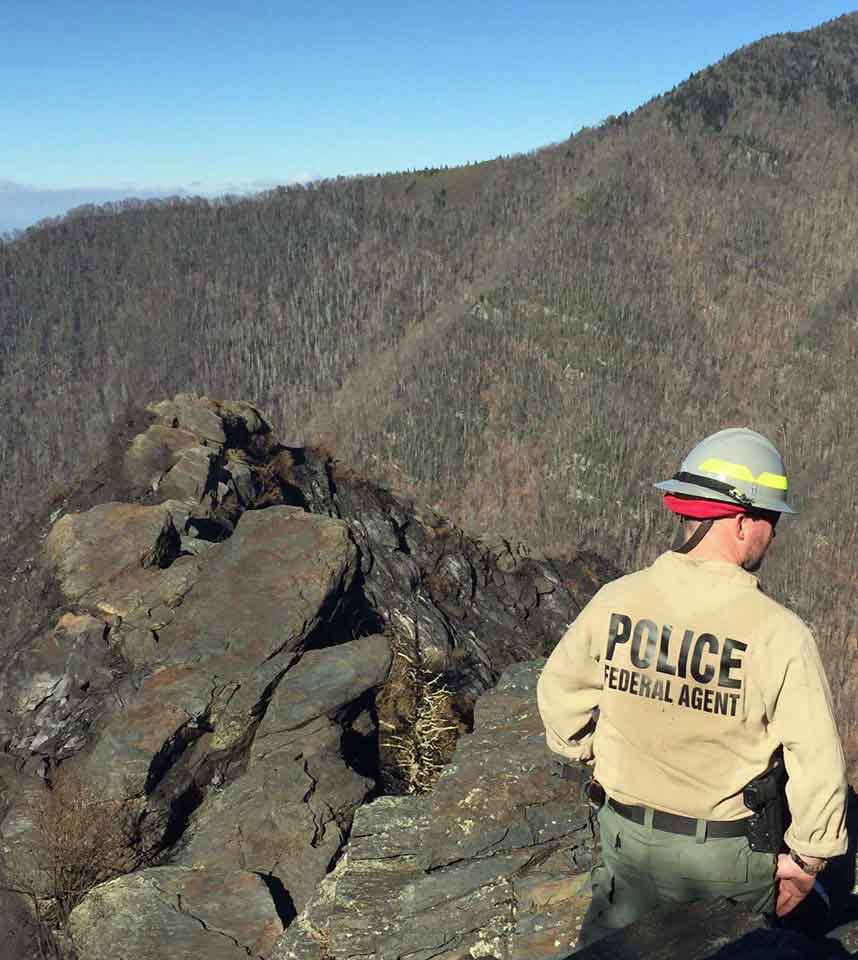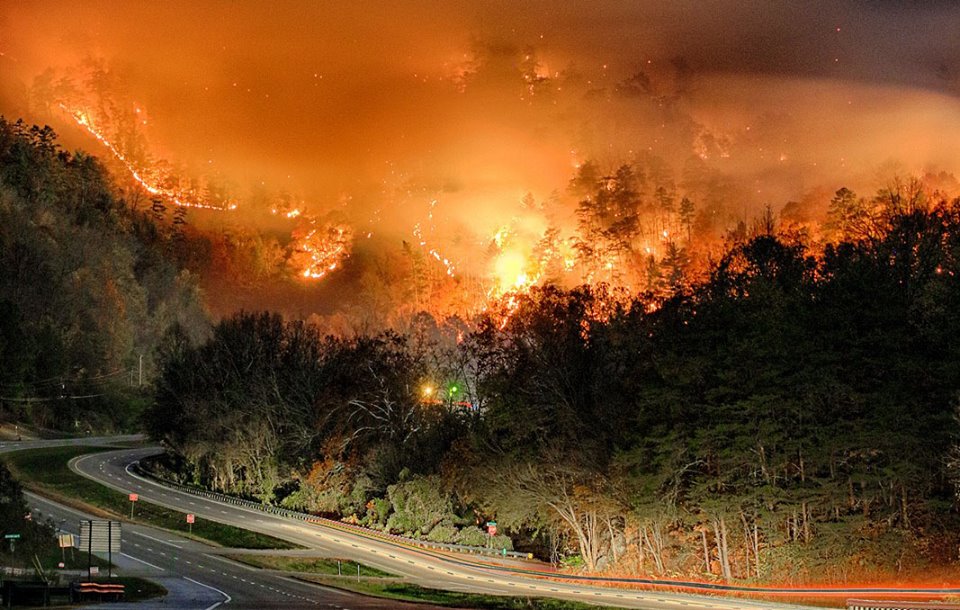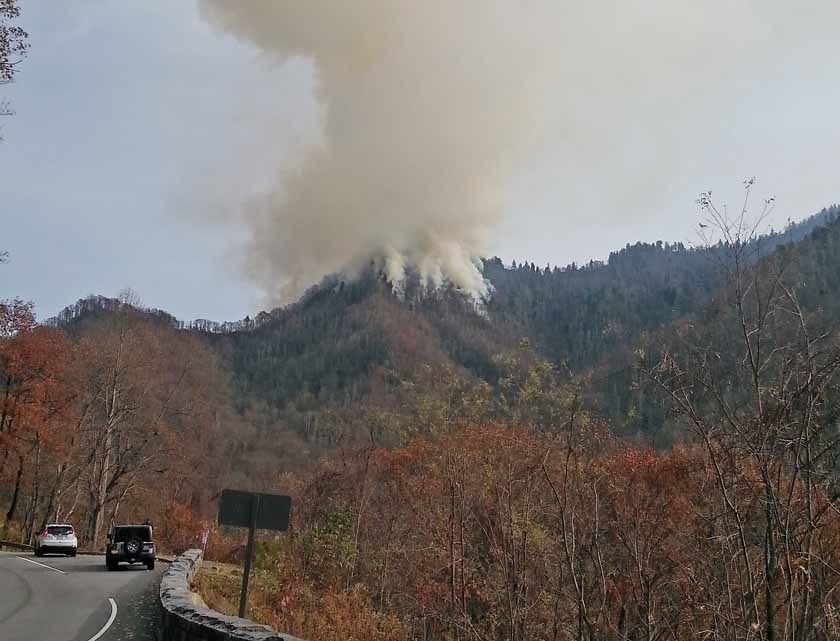Above: Fire Management Officer Jeff Schardt talks about managing the Rough Ridge Fire.
I had never heard of a organized multi-day road trip that involved visiting several large fires that burned in previous years, so when the Consortium of Appalachian Fire Managers and Scientists (CAFMS) distributed notices about one I was very interested. Their plans were to spend about a half day each at three fires in three states over a three-day period. The fires occurred last fall in North Carolina, Georgia, and Tennessee. Since they were pretty far apart the remaining half days were devoted to traveling in a bus (or coach) to the sites. At each location we would meet with local subject matter experts that would explain how the fires were managed, the effects on the natural resources, and the social issues.
So I signed up.
The expedition was primarily organized by two folks from the CAFMS, the director Helen Mohr, and Jenifer Bunty, their Public Information Coordinator.
Ms. Mohr is a researcher that has been working with the USFS’ Southern Research Station until recently when she was selected as Director for the CAFSM, and said she now spends most of her time with that organization.
Ms. Bunty has bachelor’s degrees in biology and Russian, obtained a master’s in biology, has conducted research in the Russian Far East, and has worked for the Southern Blue Ridge Fire Learning Network. She is now working remotely for the CAFSM from China (yes, that China), but commuted to the Southeast for this road trip.
There were approximately 12 to 15 people that were on the journey for all three days, but at each stop others joined to talk about or learn about that particular fire. At the Rough Ridge Fire two or three dozen students from Clemson University’s forestry summer camp joined us.
I posted a gallery of photos taken on the trip.
Day 1 of the Road Trip, June 6, the Party Rock Fire
This fire started November 5, 2016 and blackened about 7,100 acres mostly in Chimney Rock State Park at Lake Lure in western North Carolina.
We met the first day at 8 a.m. in Flat Rock, North Carolina where we boarded the coach for a 30-minute trip to Lake Lure and heard presentations by the officials from Chimney Rock State Park and the mayors of Lake Lure and Chimney Rock Village. They discussed the effects on their populations, the evacuations, and the suppression of the fire.
Then after viewing the fire in the distance from a viewpoint, the group began a strenuous hike to a point called Party Rock, up a very steep washed out abandoned logging road — 2.4 miles round trip with a 1,500-foot elevation gain. After lunch and various discussions about fire effects, five hours later we reboarded the thankfully air conditioned coach.

In another two hours we were at a motel in Gatlinburg, Tennessee.
More information about the Party Rock Fire can be found at Wildfire Today and Inciweb. (Update Oct. 9, 2018: it is no longer available on Inciweb)
Day 2 of the Road Trip, June 7, the Chimney Tops 2 Fire
The Chimney Tops 2 Fire started in southeast Tennessee November 23, 2016 inside Smoky Mountains National Park and six days burned into Gatlinburg killing 14 people, forcing 14,000 to evacuate, destroying or damaging 2,400 structures, and blackening 17,000 acres.
A short drive that morning took us to a turnout on US Highway 441 where the Park’s Fire Management Officer Greg Salansky told us about the first six days of the Chimney Tops 2 Fire. Later at different locations we heard a talk by Fire Ecologist Rob Klein about fire effects on vegetation, and Jessica Giacomini and Cory Blair presented information about the effects on animals.

Ms. Giacomini said of the 50 black bears in the park that have radio collars, 20 of them were in the fire area at the time. All of those survived, but two that were not collared died; one was found dead and the other had to be euthanized due to its serious injuries. She said the collared bears hunkered down and remained in the fire area as it burned. This will provide a very rare opportunity, she said, to find out what bears do before, during, and after a wildfire.
That day the group viewed the burned area from several different vantage points, hiked the Cove Mountain Trail, and heard from Emily Snider of UNC and Joe O’Brien of the USFS about various fire intensities, the effects on Table Mountain Pine, and delayed mortality of the overstory.
The day ended with a 2.5 hour coach ride to Dalton, Georgia.
More information: Mr. Salansky’s presentation to the group; general coverage of the Chimney Tops 2 Fire at Wildfire Today, and Inciweb. (Update Oct. 9, 2018: it is no longer available at Inciweb)
Day 3 of the Road Trip, June 8, the Rough Ridge Fire
The Rough Ridge Fire started on October 16, 2016 in the Cohutta Wilderness of northern Georgia and burned almost 28,000 acres in the Chattahoochee-Oconee National Forest.
A 30-minute coach ride took us from Dalton, Georgia to the Conasauga Ranger Station in Chatsworth where we heard from District Fire Management Officer Jeff Schardt.
This was the location where we were joined by two to three dozen forestry students from Clemson. After the initial presentation at the District Office, we all got back into our coach and the vans the students traveled in, and the convoy visited several sites in the footprint of the fire.
Areas treated with prescribed fire over the years were taken advantage of in several locations around the perimeter, and the group saw some of the effects of those projects. The reduction in fuel lowered the fire intensity and served as logical points at which to stop the fire.
Karen Larson, Recreation Program Manager on the District, told the group about issues related to managing a fire in a federal wilderness area, and how the decisions were made initially about suppression tactics.
District Biologist Ruth Stokes covered the impacts on animals. She said bats are migratory and had already left for their hibernation sites in caves. The fire may have destroyed some den trees that bears like, but the fire probably created quite a few more.
Ms. Stokes said that some fish were killed along several miles of the Conasauga River on the northwestern fire perimeter. The exact cause is not certain, but they think it may have been a result of ash deposition in the water. That area, she said, was heavily impacted by smoke. Fire retardant dropped by aircraft was not used in that area.
More information about the Rough Ridge Fire: Wildfire Today and Inciweb.
Summary
At all three fire sites we were told that access was extremely difficult and that issue had a very significant effect on the selection of suppression alternatives and the ultimate size and duration of the fires.
This is the first multi-day, multi-fire organized road trip that I am aware of. Depending on your interests, if there are ever any more you might find it as interesting as I did. Unfortunately, when someone asked Ms. Mohr, the director of CAFMS, if she would organize more in the future, her very quick answer was, “No”.
I found the 3-day road trip very interesting and worthwhile, and hope the CAFMS and other groups conduct more.
A much shorter trip on the other side of the country occurred today, planned by Utah State University and billed as the “Second Annual Wildland Fire Tour”, a six-hour event south of Tooele, Utah. The topic was mechanical treatments such as mastication. There was no indication that they would tour a prescribed or wildland fire. It was live-streamed; I watched a few minutes of it but it looked like it was filmed with a cell phone and the wind noise on the mic made it very difficult to hear the speaker. The group was using a nifty portable PA system that appeared to have a hand-held wireless mic. I could not tell if the speaker/amp, about the size of a carry-on suitcase, was battery powered or if there was a power cord that I could not see.







